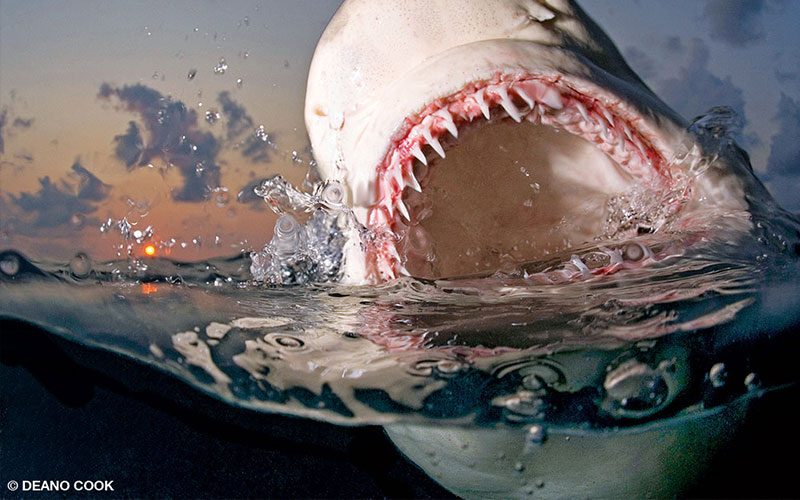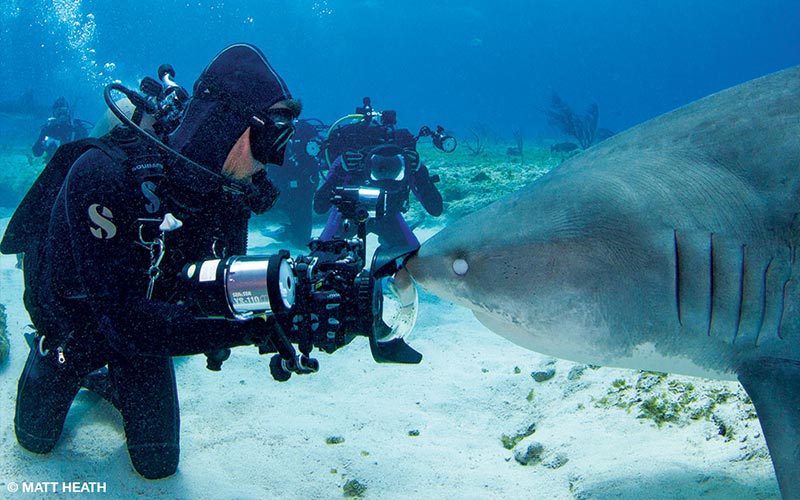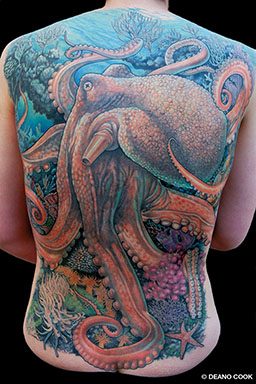Hometown: Atlanta, Ga.
Years Diving: 21
Favorite Destination: The Bahamas. I consider it my backyard.
Why I’m a DAN Member: For the diving insurance, the continuing safety education and Alert Diver magazine — I love the quality and enjoy the articles on imaging. [Note: Cook won Alert Diver’s 2013 Ocean Views Photo Contest.]
To convey the sheer wonder and amazement of the underwater world and its inhabitants, Deano Cook’s preferred medium is skin and ink.
His body of work — thousands of sprawling, richly colored seascapes replete with giant octopuses, sea turtles, blue marlins, corals, orcas, dolphins, divers, and sharks, always sharks — adorns the bodies of his clients and has made him a cult hero to ocean insiders and tattoo aficionados alike.
The 45-year-old visual polymath — he also paints and is an award-winning underwater photographer — typically takes his own reference photos for tattoos. “I like to take my art from sea to skin,” Cook explained. “It makes my work a more intimate experience.” But be prepared: One of his larger creations (an inked sleeve, for instance) will set you back the cost of a new rebreather.

Andy Dehart, vice president of animal husbandry at the Patricia and Phillip Frost Museum of Science in Miami and the shark advisor for Discovery Channel’s “Shark Week,” has served as Cook’s chainmail-clad bodyguard on shark photographic treks. He said Cook’s passion for the ocean and his deep understanding of color and light enable him to capture animals in their true form.
Cook initially inked on the aquarist’s upper right arm a half sleeve featuring Emma, a tiger shark Dehart worked with at Tiger Beach, Bahamas. The tattoo subsequently grew to include two lemon sharks. “It’s like wearing a Picasso on your skin,” Dehart said.

Cook’s predilection for water and art is in his blood. His father had a master’s degree in photography and worked as an illustrator. When Cook was young, his uncle would take him fishing, crabbing and snorkeling in Panama City, Fla. That’s where Cook encountered his first shark, which became a subject for his early paintings.
Cook started building his portfolio at an early age. He painted backdrops for his school and pored over art books. His mom enrolled him in oil-painting classes. But there was no money for art school, so at 17 he left home and went to work as a house painter. He also painted cars for a local dealership.
After showing his portfolio to a local tattoo shop owner in 1993, he was hired on the spot. When the shop closed a year later, Cook opened Psycho Tattoo, which he still operates today. This enabled Cook to marry his color-realism-based art with tattooing when the realism movement in tattooing was on the rise. Today in ink circles he is regarded as a pioneer.

Cook soon realized a long-held dream by becoming a scuba diver. Soon afterward he started using point-and-shoot cameras to bring back underwater images to show his friends, then he began incorporating ocean art into his business.
By the late ’90s Cook had become known for his portraits and pin-up-girl tattoos. “They put me on the map, but I wasn’t connecting with my clients,” he explained. In contrast, his ocean art was attracting like-minded individuals. “I was meeting marine biologists and documentary filmmakers, and I realized that water people were my people,” he said.
Cook met marine artist Wyland in 2000, and a few years later he helped Wyland paint his 88th whaling wall mural in Destin, Fla. He went on to help paint four more. Wyland, who now boasts a Cook sleeve, inducted him into his Ocean Artists Society.

Cook learned how to photograph sharks under the tutelage of pioneer Stuart Cove and participated in Cove’s early Shark Shootouts in the Bahamas. He took several of Stephen Frink’s master classes and also worked with shark conservationist and underwater image-maker Jim Abernethy. “If it were up to me, every dive would be a shark dive,” Cook said. “They’re my spirit animal, if there is such a thing. I love them and have adopted their plight as a cause of great personal interest.”
When he’s not on a dive trip, Cook works from his shop in Marietta, Ga. He tattoos only one client a day and is typically booked a month in advance. More than half of his clients are from out of state. Many, like shark advocate and videographer Jillian Morris Brake, return periodically for Cook to complete or expand on their tattoos.
Brake met Cook a decade ago through Wyland and felt an immediate connection. To date she has invested 26 hours in the exquisite great hammerhead that covers her back. “Deano has captured my life and passion in art,” she explained. “He is connected with the ocean and with these animals. It’s a special bond that we share.”
Brake’s hammerhead, a work in progress, is imbued with an energy that makes it look almost alive. “Anyone can paint a hammerhead, but to convey the movement and the story of that animal takes someone who knows sharks,” she said. “It’s more than just a tattoo.”
Perhaps the power of Cook’s work is what the 19th-century French artist Edgar Degas had in mind when he suggested that art is not what you see but what you make others see. Of that Cook is acutely aware. “I try to raise awareness and stimulate conversations about the ocean as a purposeful, mindful endeavor through my work,” he said. “If as a result I change the hearts and minds of a few people, that’s great.”
| © Alert Diver — Q1 2017 |